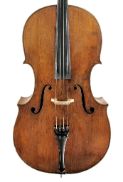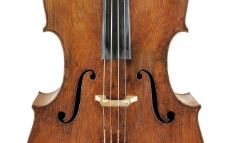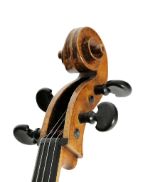Violoncello, Giovanni Tononi, Bologna, 1681
Printed label: “Ioannes Tononus fecit. Bononiæ / in Platea Pauaglionis. Anno 1681.”Giovanni Tononi was one of the most renowned violinmakers in Bologna. As the printed label states, his workshop was located at Piazza Pavaglione in the center of town, close to the Basilica San Petronio, when he crafted the violin in 1681. Like many 17th-century cellos, this instrument originally had somewhat larger dimensions. The upper and lower bouts were later shortened marginally. This cello, like some others from this era, had what was likely a procession hole drilled into the back about 6 cm below the button. A hook had been inserted in this hole (now plugged) so that the instrument could be carried on a strap during processions. Its belly is made of five parts. On the treble side, the wood displays some irregular growth as well as a few small knots. A dendrochronological analysis was inconclusive. The two-part, quarter-cut back is made of unflamed maple. On the bass side, a knot can be seen in the top third of the back. The structure of the rib wood corresponds to that of the back. The pegbox and scroll are fashioned from unflamed maple. Because the cello was modified, the arching begins immediately after the purfling, above all in the upper bouts. The f-holes are slanted and a bit asymmetrical. The cello has perfectly round eyes whose design recalls Niccolò Amati. Its powerful, highly sculptural scroll showcases Tononi’s creative power. Tononi dispensed with smoothing away the toolmarks, so the direction of cut in carving the volutes is clearly recognizable. Especially the view from the front reveals the asymmetrical execution of the two volutes. The delicate chamfer is not affected by signs of wear. A red-brown color varnish coats a luminous, golden-yellow ground.






